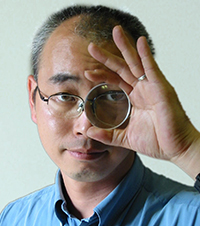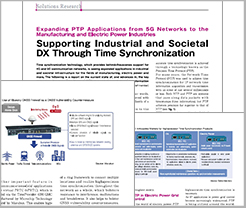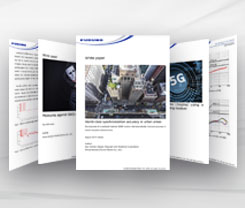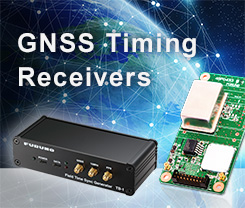Column
Why Time Synchronization is Vital for Criminal Investigations, Seismograph Measurements and Solar Wind Observation
Rectifying Start- and Finish-line Mix-Ups
During the sports day event at an elementary school, I have photographed the kids in action using two cameras, one with telephoto and the other with wide-angle lenses. While feeling satisfied with a lot of photos taken, I sat down on my computer to sort through the image files, when I found that the order was all mixed up. In some cases, the race finish-line scenes came right before the start-line scenes; it was truly taxing to get everything back in order.
I'm sure you have already guessed the cause of this phenomenon. On digital photographs, the Metadata like time, exposure settings, model name of the camera, and so are recorded with the pictures. The file manager program on my computer sorts photos in chronological order (by time taken), and because I had used multiple cameras whose internal clocks have not been synchronized, the pictures were in incorrect order and resulting as this troublesome task.
This could have been all avoided had I simply synchronized the clocks of my cameras before starting...which is something I frequently forget to do. When it comes to sorting through the sports day photos, out-of-sync clocks only lead to a bit of extra work (which can sometimes be fun!). However, when using camera footage to conduct a criminal investigation, the problems can become much bigger.
Tracking a Criminal Using Security Cameras
In August 2021, an injury incident occurred in which subway passengers had been sprayed sulfuric acid, in Minato Ward, Tokyo. The police used security camera recordings to track the criminal's movements, resulting in an impressive relay-type investigation based on footage from multiple locations. When investigating a crime in this manner, the police look at where the criminal was prior to the crime as well as their escape route following the crime. During the initial stages of the investigation, nailing down the chronological order of camera footage in relation to these pre- and post-crime phases is of the highest priority.
Understanding where the criminal initially came from may reveal the location of his home; determining where the criminal went afterward can lead directly to their apprehension. After the Tokyo acid attack, investigators rushed to the station and began examining security camera footage around the crime scene. (Source: Mogami, Kazuki. "Maeashi to Atoashi o Oe: Ryusan Jiken, Bohan Kamera de Sematta Keijitachi no 84-Jikan" ["Pre- and Post-crime Routes: Investigators Spend Eighty-four Hours Tracking Criminal via Security Camera Footage Following Sulfuric Acid Attack"], 17 October 2021, Mainichi Shimbun.)
Camera footage is necessary to track the movements of the criminals amid the crowded Tokyo subway station, focusing on details such as which ticket gates they used, which route they took through the station, which platform they used, and which train and car number they rode. If this had been a televised crime drama, the detectives probably would have pinpointed the criminals right after the commercial break. In real life, however, police have the arduous task of going over train schedules for the day, maps of the station, camera footage and so forth, then comparing these under close scrutiny.
Throughout all of this, one factor is pivotal to all aspects of the investigation: accurate time synchronization for the security cameras.
By checking timestamps, the police can determine how long it took the criminals to go from the ticket gates to the train platform, and which train they chose if they transferred at any station along the way. Of course, all cameras have blind spots, so when they leave the visual range of one camera, investigators have to guess the time at which the criminals will appear in view of another, eliminating possibilities one step at a time. When doing such an investigation, if all the cameras' clocks are not synchronized, the size of the search area will continue to expand until locating the criminals becomes unfeasible. In other words, the network of time synchronized cameras can be expressed as a giant net to catch the criminals.
Large-scale Surveillance Networks Made Possible by Time Synchronization
When discussing observational and surveillance networks, one of the first things that comes to mind is the seismic observation network. Through this network, it is possible to determine earthquake's epicenter location and depth directly after the tremors occur by utilizing observation stations in multiple locations, which accurately acquire and calculate the arrival times of seismic waves. Just a quick review of this measurement method: The difference between P-wave(fast) and S-wave(slower) arrival times is used to estimate the distance to the epicenter, and the estimated distance from the measurement point is used to establish a radius to draw a circle (or sphere surface). This is repeated from multiple measurement points, and the location where the circles intersect can be used to determine the epicenter's location and depth. All components of a time-synchronized seismic observation network work together as one massive and interconnected system that detects and analyzes subterranean seismic phenomena.
When moving up from the earth into the realm of outer space, we find that observation networks rely even more on accurate time synchronization than networks on the ground. Nagoya University's Institute for Space–Earth Environmental Research (ISEE) uses a unique approach to observe solar winds from the sun. In broad terms, their techniques and approach are as follows:
- Visually speaking, atmospheric fluctuations make stars twinkle. But when celestial objects are viewed in terms of their electromagnetic waves—as sources of EM waves, in other words—atmospheric fluctuations have little effect.
- A selected celestial object is observed from three locations which are distant from the others.
- At times, the identical flickers of EM waves are observed at nearly the same exact time from all three observation locations.
- Such flickers are caused either by changes in EM wave strength from the original celestial body itself, or else by localized plasma concentrations within the space through which the waves travel. The cause is often the latter, which is brought about by solar winds.
- By observing large numbers of celestial objects throughout space in this manner, it is possible to determine and map out the ways in which solar winds are transmitted.
ISEE's Division for Heliospheric Research uses three radio telescopes located in Toyokawa, Fujikawaguchiko and Kiso, which are roughly spaced about 100 kilometers apart from each other, to conduct observations and measurements as described above. Nagoya University Associate Professor Kazumasa Iwai, who is a member of the same division, explains as follows:
"When solar winds impact the atmosphere above observation points, atmospheric disturbances occur. When this is observed by all three stations with very slight time differences, the last location from which it is observed is the downstream end. Each chronological variance correlates with the time taken to travel between measurement points [100 kilometers distance] by solar winds. In order to accurately measure the speed of fierce solar winds moving at hundreds of kilometers per second, precise time synchronization among the observation stations is of the utmost importance."
 Cylindrical parabolic radio telescopes are located in Kiso, Nagano (top-left image); Toyokawa, Aichi (bottom-left image); and Fujikawaguchiko, Yamanashi (right-hand image). Each telescope comprises 1,000 stainless-steel wires installed parallel to the ground's surface between 4 tusk-like protrusions. These wires extend east–west for 100 meters and north–south for 20 meters to create a parabolic reflection surface and are designed to detect at the 327-MHz bandwidth. (Photographs provided by Nagoya University ISEE.)
Cylindrical parabolic radio telescopes are located in Kiso, Nagano (top-left image); Toyokawa, Aichi (bottom-left image); and Fujikawaguchiko, Yamanashi (right-hand image). Each telescope comprises 1,000 stainless-steel wires installed parallel to the ground's surface between 4 tusk-like protrusions. These wires extend east–west for 100 meters and north–south for 20 meters to create a parabolic reflection surface and are designed to detect at the 327-MHz bandwidth. (Photographs provided by Nagoya University ISEE.)
Solar Winds as a Threat to GNSS, and Our Ability to Confront That Threat Using GNSS
In a previous article, I wrote, “creatures living on the bottom of the sea can tell what is happening on the surface of the water by the shimmering of light reaching the bottom, such as "It is quiet today" or "There are waves today." Similarly, we can visualize waves propagating through the ionosphere by looking at radio waves coming from GNSS." (Original article: "The Day-after Superflare -Effects on power and wireless communication infrastructures-")
The aforementioned radio telescope network, which is time-synced to a highly sophisticated degree, makes it possible to do more than just visualize EM wave patterns. By using this network, we can tell if a major solar storm comes, and determine far in advance when that storm will arrive. Remote observation stations that utilize time synchronization often rely on GNSS systems. However, powerful solar winds caused by a superflare-triggered solar storm, for which there is a certain possibility of occurring in the future, pose a significant threat to society as a whole through upsetting of measurements that rely on GNSS time synchronization and positioning. With this in mind, it's fascinating to think about the ways in which GNSS time synchronization technology supports operations in the field of solar wind observation.
Writer introduction

Mr. Mitsunari Kita Science and technology writer
Born in Ishikawa Prefecture in 1964. Based on his experience in covering industrial technology, cutting-edge technology, and space development, he is passionate about unraveling and conveying difficult topics in an interesting way to people of all ages, from children to senior citizens. From 2009 to 2014, he was a member of the editorial board of "JAXA's," the official magazine of the Japan Aerospace Exploration Agency. Author and co-author of the following books: 『あなたにもミエル化? ~世間のなりたちを工学の視点から~』(幻冬舎mc)、『私たちの「はやぶさ」その時管制室で、彼らは何を思い、どう動いたか』(毎日新聞社)、『東京大学第二工学部70周年記念誌 工学の曙を支えた技術者達』(東京大学生産技術研究所) etc.,
* All registered trademarks used herein are the property of their respective owners.
Pick up
Column
FURUNO Column
-
Common Problems That Affect GPS/GNSS Time Synchronization

-
How to select GPS/GNSS antennas for time synchronization

Column by Mr. Mitsunari Kita (Science and technology writer)
-
The Observation Network Created by the Earthquake Proves Useful for Accurate Timekeeping (Part Two of Two) - A Solution to the "Mr. Higgins Problem" in Space -

-
The Observation Network Created by the Earthquake Proves Useful for Accurate Timekeeping (Part One of Two)

-
FURUNO ELECTRIC Joins Experts From Around the World on a Norwegian Island for Jammertest 2024

-
Unraveling the Mysteries of Venus Based on "Occultation"

-
Atoms as the Basis for Measuring Both Fleeting Moments and Near-Eternities

-
Time Progressing with a Speed Difference of Just 4.4647 Ten-Billionths!

-
Critters Who Revitalize Forests Through the Spreading of Food Caches

-
Small But Significant Variances in Gravity and Time (Part Two of Two)

-
Small But Significant Variances in Gravity and Time (Part One of Two)

-
Why the GT-100 Time-synchronization GNSS Receiver Module is Like Fragrant Soup Curry

-
What Rainbows Can Teach Us About Dual-Band GNSS

-
The Amazing Things That Are Possible With Just a Clock

-
When Subterranean Earth Meets Outer Space

-
Using the TB-1 and GT-100 at a "Multipath Dojo" in the Major Metropolis of Osaka

-
The Disaster-struck Field Time Sync Generator TB-1: True Performance Revealed Through a Lightning Strike

-
Knowing the "Now" of Our Earth Through GNSS

-
The Reason GPS Counts Time in 1.5-second Intervals

-
Similarities Between "On My Count!," the 117 Notification System, and GPS

-
Reliable Clocks Help Us Find a Silver of the Clouds

-
Why Time Synchronization is Vital for Criminal Investigations, Seismograph Measurements and Solar Wind Observation

-
What Was "Cesium" About Cesium Akina?

-
Updating Analog Broadcasting with GNSS Time Synchronization Technology

-
The Long History of One Second (Part II)

-
The Long History of One Second (Part I)

-
A Solo Journey - Three-liter Microsatellite Mission Support via GPS (GNSS) and Satellite Communication -

-
A Solo Journey - The GPS (GNSS) Tracking System That Helped Kenichi Horie Cross the Pacific -

-
The Day After a Superflare - Effects on power and wireless communication infrastructures -





